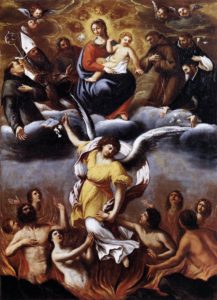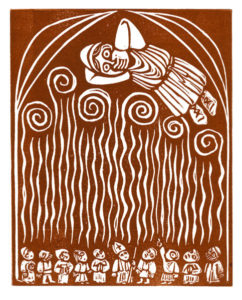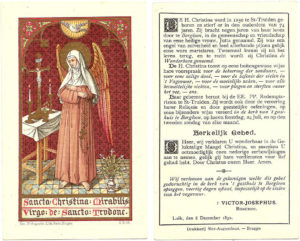St. Christina the Astonishing’s Vision of Purgatory
Does Purgatory exist? Is Hell real? When I was growing up, I thought so. I stopped believing in both places as a young adult; now I’m not so sure.
I grew up being taught to pray for people in Purgatory as well as to light candles and have Masses said for them. The living were responsible for remembering those in Purgatory in prayer and for trying to set them free to get to Heaven. 
The biggest reason I stopped believing was the stupidly of the punishment for sin: missing Mass on one Sunday, saying the Lord’s name in vain one time—after a life of goodness—could condemn a person to Hell for eternity. Conversely, a person who lived a mean, cruel, self-centered life could avoid any consequences by one expression of repentance at the end. If God is merciful—and I believe God is—then it seems more measured to consider the whole span of life. God may not follow my logic.
Was Purgatory as a place conceived as a place of purification? Purgatory was a relatively new formal teaching for Christians when St. Christina the Astonishing experienced it in the 12th century; but other experiences of Purgatory were also popularized when she lived. 
The idea of purgatory as a process of cleansing dated back to early Christianity as was evident in the writings of St. Augustine and St. Gregory the Great. The 12th century was the heyday of medieval other world-journey narratives such as the account of an Irish knight in “Visio Tnugdali,” and of pilgrims’ tales about St. Patrick’s Purgatory, a cave-like entrance to purgatory on a remote island in Donegal, Ireland.
St. Christina the Astonishing was born in 1135 at Brustem, near Liege, Belgium. She was orphaned as a teenager and worked as a shepherdess. She had two older sisters. Sometime in her early 20s, she suffered a massive stroke or seizure. When people found her in the field, she was limp and unresponsive. Unable to hear a heartbeat or feel breathing, everyone assumed she was dead.
She was carried into church for her funeral Mass in an open coffin. After the Agnes Dei she suddenly sat up and flew up to the rafters “like a bird” and perched there. All the mourners except the priest and her oldest sister fled. Christina said that had taken refuge up there because she could not stand the smell of sinful human bodies. The priest reached out to her and told her to come down. She told him angels had guided her into a dark place where she saw many people she had known in torment. This was Purgatory. Then she was taken to Hell, where she saw other people suffering. Finally, she was taken to Heaven and given a choice: stay in Heave or return to earth to offer penances for those in Hell and Purgatory so they might be released. Her suffering would also help to convert the living. She immediately woke up when she chose to return to life.
After her experience of death and vision of Purgatory, Hell and Heaven Christina felt called to suffer for others so they could be released from suffering. She voluntarily lived in extreme poverty, homeless and dressed in rags. She lived by begging. She often fled to remote areas, climbed trees and rocks. She hid in ovens. Christina avoided human contact as much as possible, saying she couldn’t bear the spiritually stinky smell of sinful people. 
Christina also sought out suffering to increase the penance she felt she must endure. People watched her intentionally throw herself into fires and remain there for extended periods of time. She would appear to be in terrible pain, but then would exit the fire completely unharmed. She allowed herself to be attacked and bitten by dogs and would intentionally run through thickets of thorn bushes. In the winter, she would plunge into the freezing Meuse River. The current sometimes carried her downriver to a watermill where the wheel “whirled her around in a manner frightful to behold.” Christina would emerge from all these self-torments bloody but unhurt—no scars, burns or broken bones. Despite a lifetime of abuse and hard living, Christina died at the ripe old age of 74 on July 25, 1224 at the Dominican Monastery at Sint-Truiden (Saint-Trond). She spent the last three years of her life there, and according to the prioress was generally docile and well-behaved.
People had mixed opinions about Christina. Was she insane? Was she possessed? Was she a holy woman and mystic sent to warn people about the fires and pains of Purgatory?
Centuries later, we read regularly about people who have near death experiences and believe they have glimpsed the afterlife. Most of them describe tunnels of light and bliss, but some have described a Purgatory or Hell-like place. We also know now that people who experience a hypoxic-anoxic brain injury can wake to cognitive, physical and psychological changes. This injury appears to be what happened to St. Christina the Astonishing. She most likely had a heart attack or massive stroke and oxygen didn’t reach her brain for several minutes or longer, resulting in a deathlike state and permanent brain damage.
Several saints besides St. Christina have had a vision journey to Purgatory and back. They include St. Catherine of Genoa, St. Lidwina of Schiedam, and St. Maria Faustyna Kowalska, the saint who inspired Divine Mercy Sunday. Several of the “seers” of Medjugorje have visited Purgatory, Heaven and Hell with the Blessed Mother, who regularly sends messages to the seers about these places and the people populating them. The main message is that they need to believe in them, pray and do penance to help the people who are there. There is nothing new or original in these visions. We have seen the same scenes in paintings, stained glass windows, catechism lessons, books and TV.
Jesus mentioned Paradise and Gehenna, but never a place like Purgatory. Was it concocted as a way station for pilgrims on their way home or a course correction for the living? Does Purgatory answer a primal need for a connection to the dead; and prayer and penance a way to commune and express our care and love for them? It is also an outreach to the forgotten—something the Church teaches us to honor in the here and now.

September 11th, 2019 at 8:10 pm
Invented to scare the living daylights out of the faithful in the interest of maintaining the power of the church and fueling the sale of indulgences.
June 29th, 2024 at 2:39 am
Polo: That is the same argument Nietzsche makes…every belief system is a quest for power… No Nietzsche, people generally believe things because they think they are true. Mathematicians don’t espouse math to control my mind and numerate it. Similarily, the Catholic Church teaches what it sincerely believes to be revealed by God. The Church gains nothing by scaring people…if it wanted control it would teach a bunch of pleasant things easily agreeable.
Purgatory is a doctrine that comes from Sacred Tradition — which Catholics hold is also inspired by God.